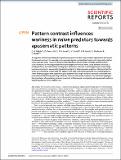Files in this item
Pattern contrast influences wariness in naïve predators towards aposematic patterns
Item metadata
| dc.contributor.author | Halpin, Christina G. | |
| dc.contributor.author | Penacchio, Olivier | |
| dc.contributor.author | Lovell, P. George | |
| dc.contributor.author | Cuthill, Innes | |
| dc.contributor.author | Harris, Julie | |
| dc.contributor.author | Skelhorn, John | |
| dc.contributor.author | Rowe, Candy | |
| dc.date.accessioned | 2020-06-23T09:30:02Z | |
| dc.date.available | 2020-06-23T09:30:02Z | |
| dc.date.issued | 2020-06-08 | |
| dc.identifier.citation | Halpin , C G , Penacchio , O , Lovell , P G , Cuthill , I , Harris , J , Skelhorn , J & Rowe , C 2020 , ' Pattern contrast influences wariness in naïve predators towards aposematic patterns ' , Scientific Reports , vol. 10 , 9246 . https://doi.org/10.1038/s41598-020-65754-y | en |
| dc.identifier.issn | 2045-2322 | |
| dc.identifier.other | PURE: 268363759 | |
| dc.identifier.other | PURE UUID: 6e1ffc0f-0b82-4457-9ed4-ab8d0eadc7b3 | |
| dc.identifier.other | ORCID: /0000-0002-3497-4503/work/75248333 | |
| dc.identifier.other | Scopus: 85086167742 | |
| dc.identifier.other | WOS: 000560461000024 | |
| dc.identifier.uri | https://hdl.handle.net/10023/20124 | |
| dc.description | This work was funded by BBSRC grants awarded to J.M.H. and O.P. (BB/N006569/1), C.R. and J.S (BB/N00602X/1), P.G.L (BB/N005945/1), and I.C.C. (BB/N007239/1). | en |
| dc.description.abstract | An apparent and common feature of aposematic patterns is that they contain a high level of achromatic (luminance) contrast, for example, many warning signals combine black spots and stripes with a lighter colour such as yellow. However, the potential importance of achromatic contrast, as distinct from colour contrast, in reducing predation has been largely overlooked. Here, using domestic chicks as a model predator, we manipulated the degree of achromatic contrast in warning patterns to test if high luminance contrast in aposematic signals is important for deterring naïve predators. We found that the chicks were less likely to approach and eat prey with high contrast compared to low contrast patterns. These findings suggest that aposematic prey patterns with a high luminance contrast can benefit from increased survival through eliciting unlearned biases in naïve avian predators. Our work also highlights the importance of considering luminance contrast in future work investigating why aposematic patterns take the particular forms that they do. | |
| dc.format.extent | 8 | |
| dc.language.iso | eng | |
| dc.relation.ispartof | Scientific Reports | en |
| dc.rights | Copyright © The Author(s) 2020. Open Access. This article is licensed under a Creative Commons Attribution 4.0 International License, which permits use, sharing, adaptation, distribution and reproduction in any medium or format, as long as you give appropriate credit to the original author(s) and the source, provide a link to the Creative Commons license, and indicate if changes were made. The images or other third party material in this article are included in the article’s Creative Commons license, unless indicated otherwise in a credit line to the material. If material is not included in the article’s Creative Commons license and your intended use is not permitted by statutory regulation or exceeds the permitted use, you will need to obtain permission directly from the copyright holder. To view a copy of this license, visit http://creativecommons.org/licenses/by/4.0/. | en |
| dc.subject | BF Psychology | en |
| dc.subject | DAS | en |
| dc.subject.lcc | BF | en |
| dc.title | Pattern contrast influences wariness in naïve predators towards aposematic patterns | en |
| dc.type | Journal article | en |
| dc.contributor.sponsor | BBSRC | en |
| dc.description.version | Publisher PDF | en |
| dc.contributor.institution | University of St Andrews. School of Psychology and Neuroscience | en |
| dc.contributor.institution | University of St Andrews. Institute of Behavioural and Neural Sciences | en |
| dc.identifier.doi | https://doi.org/10.1038/s41598-020-65754-y | |
| dc.description.status | Peer reviewed | en |
| dc.identifier.grantnumber | BB/N006569/1 | en |
This item appears in the following Collection(s)
Items in the St Andrews Research Repository are protected by copyright, with all rights reserved, unless otherwise indicated.

